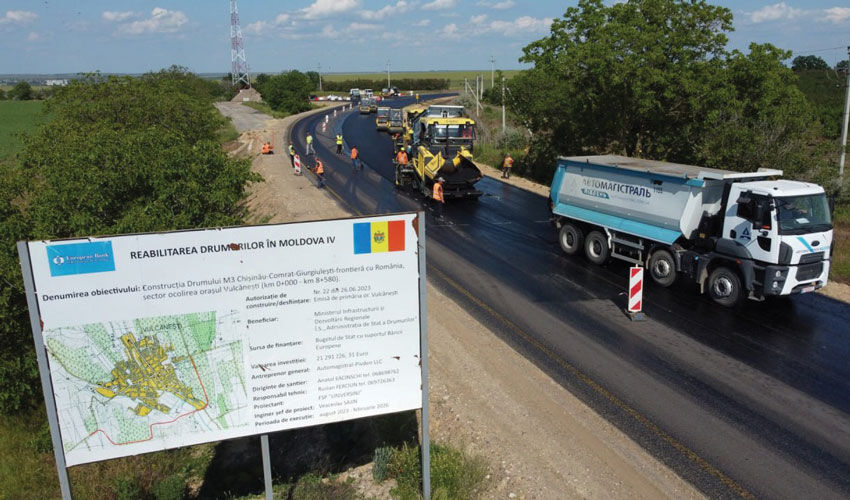
The State Highway Department (ASD) reports that on July 17, 2025, the acceptance committee found: all comments identified in the completion report have been fully addressed by the contractor.
The construction of the Comrat bypass road, 18.3 kilometers long, continued from February 2019 and was put into operation in September 2022. The road was then under the supervision of specialists during the 34-month warranty period.
Recall that in September 2018, the international tender to find a contractor for the construction of the Comrat bypass road ended, with the Turkish company ONUR recognized as the winner. In March 2019, an asphalt-concrete plant of the same Turkish company started operating in Budjac village, a suburb of Comrat, while ONUR started the construction of the bypass road.
It is part of a large-scale project to rehabilitate the national highway M3 Chisinau-Comrat-Djurgiulesti-Romanian border. In fact, it is a strategic highway from the center to the south of Moldova. The highway provides a link to the port of Giurgiulesti for access to the Danube and the Black Sea, as well as access to EU countries and the Balkans.
The whole M3 Chisinau-Comrat-Giurgiulesti highway with the length of 220 km is conditionally divided into 12 sections. And over the past years, most of them have already been rehabilitated with loans and grants from external partners.
The first contracts for the rehabilitation of the M3 highway sections were signed in the State Road Administration back in 2010, and by 2014 it was planned to complete the rehabilitation of the entire highway. For various reasons this was not done: contractors who failed to fulfill their obligations were changed, the search for and attraction of investors continued.
By the way, the M3 highway is still not fully completed: there is still a bypass road of Vulcanesti. In other words, the M3 is a classic example of a long construction project.
In this regard, some experts believe that it is not by chance that the information about the Comrat bypass road is updated today. Despite numerous difficulties over many years, this particular project was successfully completed. In addition, the Vulcanesti bypass road is very close to final completion.
The Comrat bypass road has two lanes, three roundabouts, five bridges, a railway crossing, four major intersections and eight minor intersections. More than 500 road signs have been installed on it. The total value of the contract signed by the State Road Administration with the contractor amounted to 29.4 million euros, with the funds provided to Moldova in the form of a loan from the European Bank for Reconstruction and Development (EBRD).
Several kilometers of the Comrat bypass were built back in Soviet times, in 1989-1991. However, the facility was not completed and needed to be completed. In the early 2000s, this road was included in the list of priority projects of the Eastern Partnership. It was listed in the priority plans of the Ministry of Transport back in 2014. But only in 2018 it was possible to start the concrete realization of the project.
The bypass of the capital of Gagauzia starts in the northern part of Comrat between the villages of Budjac and Ciucur-Minjir in Cimislia district and connects to the national highway M3 in the southern part of the city near the village of Kirsova. The road helped to relieve car traffic in the city.
Meanwhile, the construction of the bypass road of Vulcanesti, about the length of the road from Vulcanesti to the southern part of the city, near the village of Chirsova, is at the final stage. The Vulcanesti bypass road is about 8.5 km long. The history here is also complicated. For information: on the south-eastern outskirts of Vulcanesti in 1990-91, the bypass road was under construction, about 2.7 km of asphalted roadbed was laid, and there is still about 5-6 km left to be completed. Ten years ago, some funds were allocated for the Vulcanesti bypass road, and a grant was expected. But the project was postponed for some reason.
In June 2023, the State Road Administration signed a contract worth 21.2 million euros with the contractor – the Ukrainian company Avtomagistral Yug, which was recognized as the winner of the tender. The money was provided as a loan by the EBRD. Repair and construction works started in September 2023 and are scheduled to be completed in February 2026.
The company Avtomagistral Yug launched its own asphalt-concrete plant in Vulcanesti. The asphalt concrete produced meets European requirements and environmental safety.
A few days ago, ASD General Director Sergiu Bejan paid a working visit to the construction site. As of July 2025, the project is approximately 84% complete.



